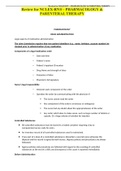Class notes
Review for NCLEX-RN® - PHARMACOLOGY & PARENTERAL THERAPY
- Course
- Institution
Review for NCLEX-RN® - PHARMACOLOGY & PARENTERAL THERAPY PHARMACOLOGY DRUG ADMINISTRATION Legal aspects of medication administration The Joint Commission requires that two patient identifiers (e.g., name, birthday, account number) be checked prior to administration of any medication. Com...
[Show more]



